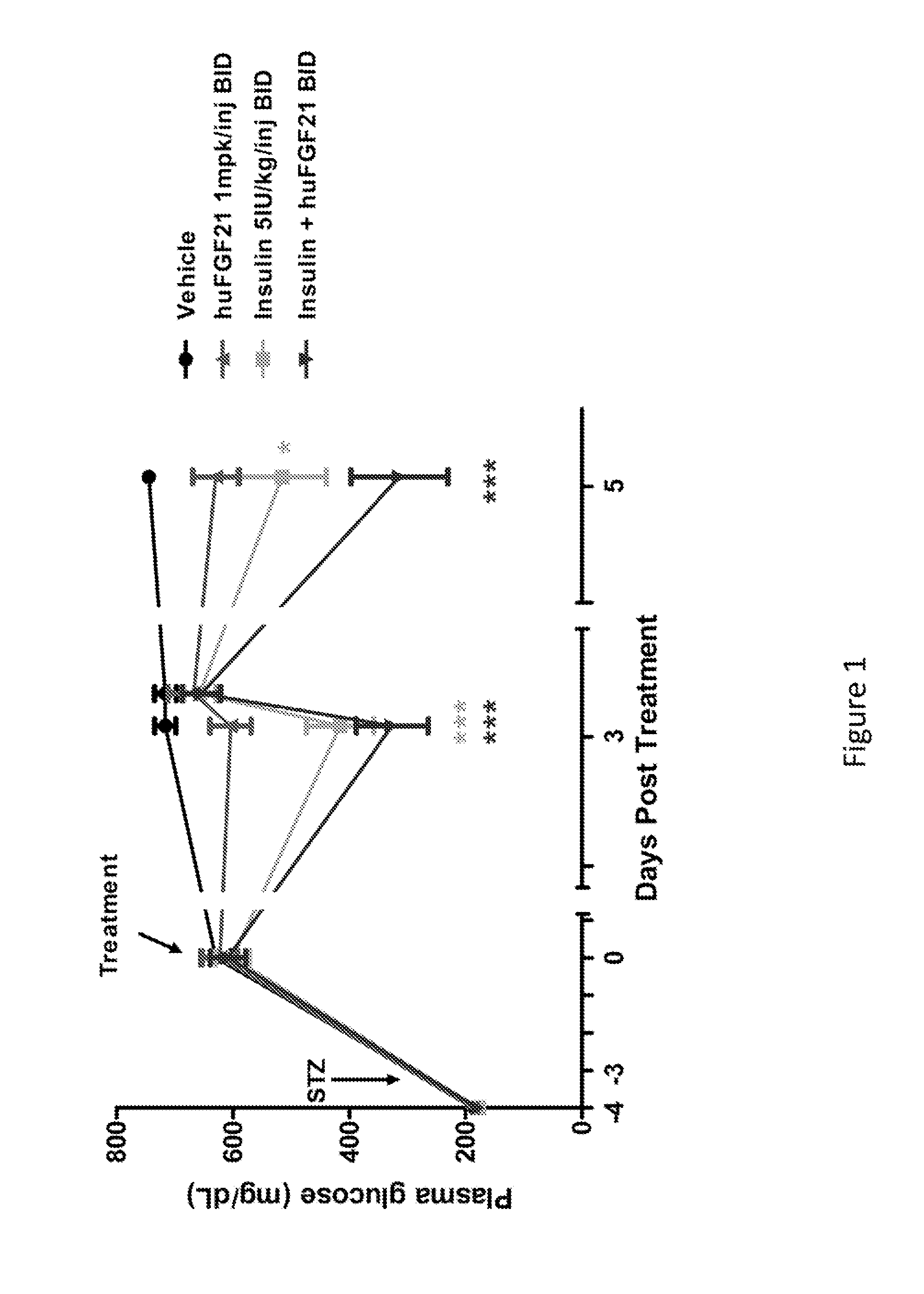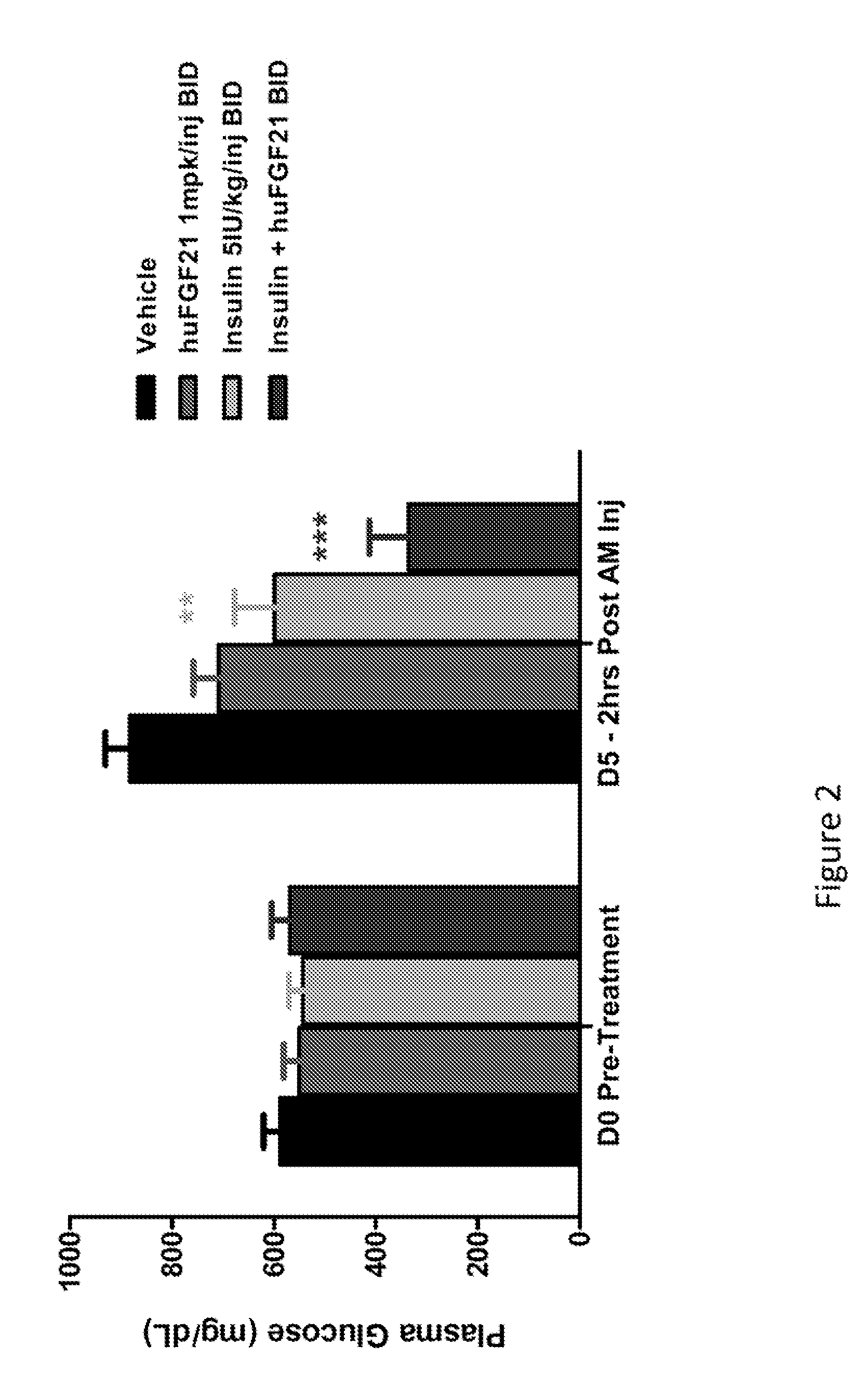Method of Treating or Ameliorating Type 1 Diabetes Using FGF21
a type 1 diabetes and fgf21 technology, applied in the field of type 1 diabetes treatment or amelioration, can solve the problems of defective and suboptimal insulin release by the pancreas, affecting the control of gluconeogenesis, and inability to produce insulin in a relatively inadequate manner
- Summary
- Abstract
- Description
- Claims
- Application Information
AI Technical Summary
Benefits of technology
Problems solved by technology
Method used
Image
Examples
example 1
Effect of Human FGF21 on High-Dose Streptozotocin (STZ)-Induced Type 1 Diabetic Mice
[0207]This study was conducted to evaluate the glucose-lowering and other metabolic effect of human FGF21 (SEQ ID NO:4), human insulin and their combination in STZ-induced type 1 diabetic mice.
[0208]Male C57BL6 mice were obtained from Harlan Laboratories and delivered at 7 weeks of age. Upon arrival, mice were single-housed and maintained in controlled environmental conditions with 12 hour light (6:30 AM-6:30 PM) and dark cycles (6:30 PM-6:30 AM). Mice were fed a standard rodent chow diet (2020× Harlan Teklad) with free-access to drinking water.
[0209]Following one week of acclimation, plasma glucose and / or body weight measurements were made. Mice were subsequently fasted for four hours by placing them into a fresh cage without chow. Mice were allowed free-access to drinking water. A single intraperitoneal (IP) injection of STZ (Streptozotocin, Sigma S-1030) at 180 mg / kg was administered into these mi...
example 2
Effect of the Dual-PEGylated Human FGF21 Variant (E37C, R77C, P171G) on High-Dose STZ-Induced Type 1 Diabetic Mice
[0217]In Example 1, it was demonstrated that native human FGF21 treatment is capable of lowering plasma glucose levels in a STZ-induced type 1 diabetic rodent model. However, this effect is short-lived, as plasma glucose levels return within four hours post injection (FIG. 1). In order to evaluate the plasma glucose lowering effects over a prolonged timeframe, two polyethylene glycol (PEG) molecules (20 kD) were chemically fused at positions 37 and 77, to a human FGF21 variant (E37C, R77C, P171G; positions of the mutations are relative to SEQ ID NO:4). This dual-PEGylated human FGF21 variant has been demonstrated to exhibit superior glucose-lowering efficacy to native human FGF21 in previous rodent studies, possibly as a result of improved pharmacokinetics. The current study was conducted to evaluate whether this dual-PEGylated human FGF21 variant could produce a sustain...
example 3
Effect of the Dual-PEGylated Human FGF21 Variant (E37C, R77C, P171G) in Multiple Low Dose STZ-Induced Type 1 Diabetic Mice (Prevention)
[0220]A multiple low dose (MLD) STZ-induced type 1 diabetic mouse model was generated. The MLD-STZ model more closely mimics type 1 diabetes development in humans than the single high dose STZ model mentioned in the previous studies. The MLD method causes gradual loss of beta cells of the pancreas as each successive low dose STZ injection. This generates an initial inflammatory response towards the beta cells of the pancreas. Over the course of 2-3 weeks, this innate immunological response increases and destroys the insulin producing beta cells of the pancreas leading to T1DM. In contrast, the single high dose STZ (180 mg / kg) method rapidly destroys beta cells in the pancreas with the first 24 to 48 hours following STZ injection. Although both methods ultimately result in insulin deficient type 1 diabetic mice, the MLD method is predominantly driven ...
PUM
| Property | Measurement | Unit |
|---|---|---|
| metabolic disorder | aaaaa | aaaaa |
| weight | aaaaa | aaaaa |
| physical activity | aaaaa | aaaaa |
Abstract
Description
Claims
Application Information
 Login to View More
Login to View More - R&D
- Intellectual Property
- Life Sciences
- Materials
- Tech Scout
- Unparalleled Data Quality
- Higher Quality Content
- 60% Fewer Hallucinations
Browse by: Latest US Patents, China's latest patents, Technical Efficacy Thesaurus, Application Domain, Technology Topic, Popular Technical Reports.
© 2025 PatSnap. All rights reserved.Legal|Privacy policy|Modern Slavery Act Transparency Statement|Sitemap|About US| Contact US: help@patsnap.com



